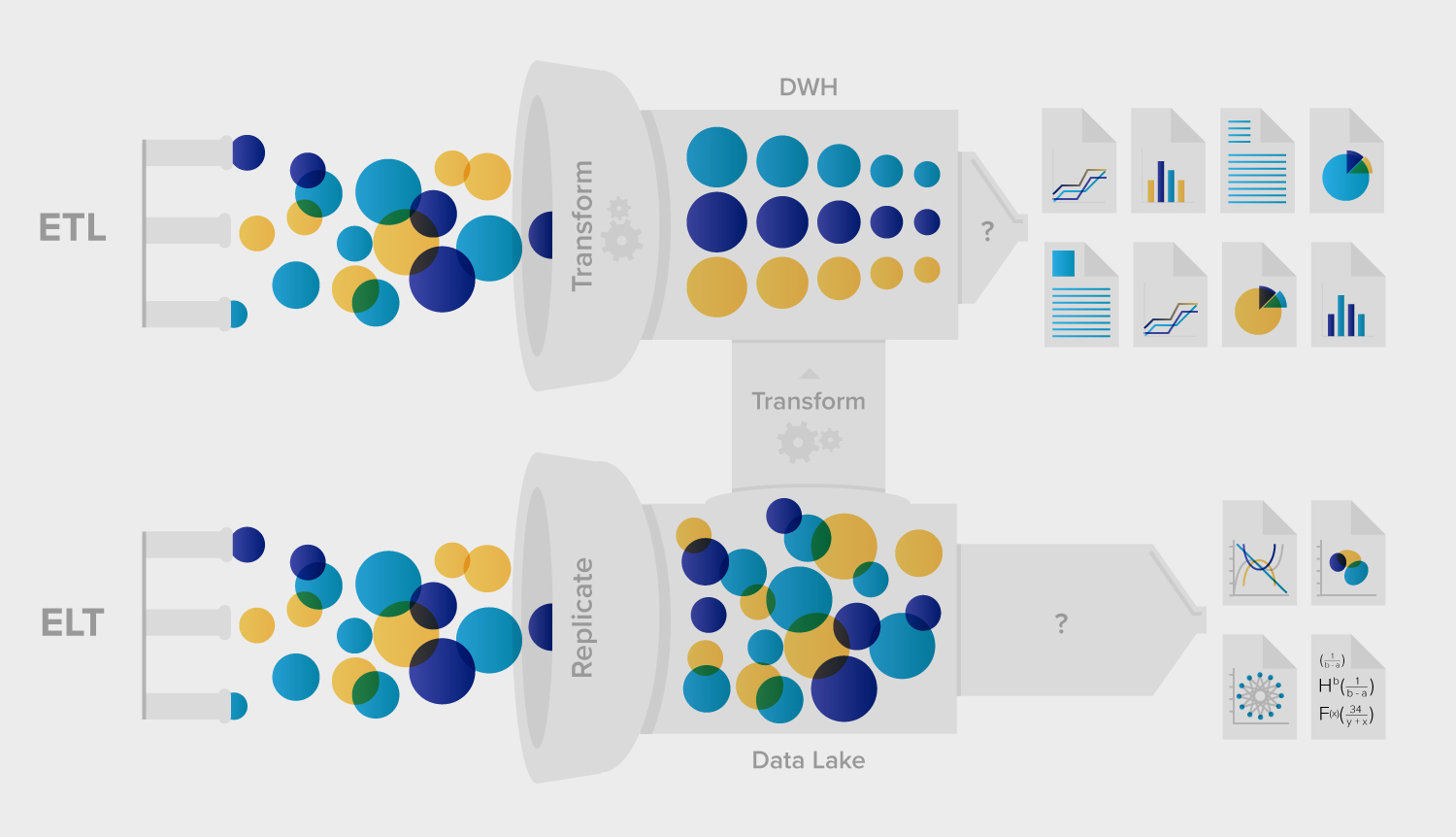Curso
Este artigo é uma contribuição valiosa de nossa comunidade e foi editado pela DataCamp para fins de clareza e precisão.
Você tem interesse em compartilhar sua própria experiência? Gostaríamos muito de ouvir você! Sinta-se à vontade para enviar seus artigos ou ideias por meio do nosso Formulário de contribuição da comunidade.
O que é integração de dados?
Atualmente, os dados orientam todas as decisões que tomamos, e é essencial compreender e utilizar dados de diversas fontes. A integração de dados é o processo pelo qual os dados de várias fontes são combinados e disponibilizados de forma unificada e coesa. Seu principal objetivo é oferecer uma visão holística, permitindo que as empresas obtenham insights valiosos, otimizem as operações e tomem decisões com base em dados e não em teoria.
ETL e ELT: Dois processos diferentes de integração de dados
Em meio à infinidade de estratégias e ferramentas de integração de dados disponíveis, ETL (Extract, Transform, Load) e ELT (Extract, Load, Transform) são as duas metodologias predominantes. Esses métodos representam abordagens distintas para a integração de dados, cada uma com suas vantagens e aplicações.

O que é ETL (Extrair, Transformar, Carregar)?
O ETL, como o acrônimo sugere, consiste em três etapas principais:
- Extrair: Os dados são coletados de diferentes sistemas de origem.
- Transformar: Os dados são então transformados em um formato padronizado. A transformação pode incluir limpeza, agregação, enriquecimento e outros processos para tornar os dados adequados à sua finalidade.
- Carregar: Os dados transformados são carregados em um data warehouse de destino ou em outro repositório.
Casos de uso e pontos fortes do ETL
O ETL é especialmente adequado para cenários em que:
- As fontes de dados são de menor escala e as transformações são complexas.
- É necessário descarregar o processamento de transformação do sistema de destino.
- A segurança dos dados é uma prioridade, exigindo transformações para mascarar ou criptografar dados confidenciais antes que eles cheguem a um depósito.
O ETL é uma excelente opção quando você precisa garantir a consistência, a qualidade e a segurança dos dados. Ele processa os dados antes que eles cheguem ao depósito, reduzindo o risco de exposição de dados confidenciais e garantindo que os dados estejam em conformidade com as regras e os padrões comerciais.
Integração de dados ETL com Python
Python, uma linguagem de programação versátil e amplamente utilizada, tornou-se uma ferramenta essencial para a integração de dados ETL. Seu rico ecossistema de bibliotecas e estruturas facilita todas as etapas do processo de ETL, o que o torna a escolha ideal para os engenheiros de dados.
Principais bibliotecas Python para ETL
- pandas: Uma biblioteca avançada para manipulação e análise de dados, o pandas simplifica a extração e a transformação de dados com sua estrutura DataFrame.
- SQLAlchemy: Essa biblioteca oferece uma maneira consistente de interagir com bancos de dados, auxiliando nas fases de extração e carregamento. Confira o tutorial SQLAlchemy do DataCamp para obter mais informações.
- PySpark: Para o processamento de Big Data, o PySpark oferece recursos de processamento de dados distribuídos, o que o torna adequado para tarefas de ETL em grande escala.
- Luigi e Apache Airflow: Essas são ferramentas de gerenciamento de fluxo de trabalho que ajudam a orquestrar e programar pipelines de ETL.
Vantagens de usar Python para ETL
- Flexibilidade: As extensas bibliotecas do Python permitem processos de ETL personalizados, adaptados a necessidades específicas.
- Escalabilidade: Com ferramentas como o PySpark, o Python pode lidar com conjuntos de dados pequenos e grandes com eficiência.
- Apoio da comunidade: Uma vasta comunidade de profissionais de dados significa que há muitos recursos, tutoriais e soluções disponíveis para desafios comuns de ETL.
A incorporação do Python nos processos de ETL pode agilizar a integração de dados e produzir uma combinação de eficiência, flexibilidade e potência. Seja lidando com bancos de dados tradicionais ou com plataformas de big data, os recursos do Python em ETL são ilimitados.
O que é ELT (Extrair, Carregar, Transformar)?
A ELT adota uma abordagem um pouco diferente:
- Extrair: Assim como no ETL, os dados são coletados de diferentes fontes.
- Carregar: Em vez de transformá-los imediatamente, os dados brutos são carregados diretamente no sistema de destino.
- Transformar: As transformações ocorrem dentro do data warehouse.
A ascensão do ELT com a computação em nuvem
A crescente popularidade da ELT está intimamente ligada ao advento de data warehouses baseados em nuvem, como Snowflake, BigQuery e Redshift. Essas plataformas possuem um imenso poder de processamento, o que lhes permite lidar com transformações em grande escala no depósito de forma eficiente.
Vantagens do ELT
- Flexibilidade: Como os dados brutos são carregados primeiro, as empresas podem decidir sobre a lógica de transformação posteriormente, oferecendo a capacidade de se adaptar à medida que os requisitos mudam.
- Eficiência: Aproveitando o poder robusto dos modernos armazéns em nuvem, as transformações são mais rápidas e mais dimensionáveis.
- Adequação para grandes conjuntos de dados: Em geral, o ELT é mais eficiente para grandes conjuntos de dados, pois aproveita o poder dos recursos de processamento paralelo maciço dos data warehouses em nuvem .
ETL vs ELT: Uma análise comparativa
Principais semelhanças e diferenças
Embora tanto o ETL quanto o ELT envolvam a extração de dados e o carregamento em um depósito, a principal diferença entre eles está no local e no momento do processo de transformação. O ETL transforma os dados antes que eles cheguem ao depósito, enquanto o ELT faz isso depois.
Velocidade e eficiência
Em geral, a velocidade de ingestão de dados do ELT supera a do ETL devido à redução da movimentação de dados. No entanto, a velocidade geral pode ser influenciada por fatores como a complexidade das transformações e os recursos do data warehouse.
Transformação de dados e conformidade
No ETL, as transformações ocorrem em um sistema intermediário, que pode oferecer um controle mais granular sobre o processo. Isso é vital para empresas com requisitos rigorosos de conformidade e manuseio de dados. Por outro lado, a ELT depende dos recursos do sistema de destino, que podem expor dados brutos e sem máscara até que as transformações sejam concluídas.
Fazendo a escolha certa: ELT vs ETL
Fatores a serem considerados
Ao decidir entre ETL e ELT, leve em consideração:
- Tipo de negócio: Uma startup pode priorizar a flexibilidade (ELT), enquanto um provedor de serviços de saúde pode priorizar a segurança dos dados (ETL).
- Necessidades de dados: Os insights em tempo real são essenciais ou o processamento diário em lote é suficiente?
- Infraestrutura: A escolha do data warehouse, as ferramentas existentes e os recursos de TI podem influenciar a decisão.
A função das plataformas de integração de dados
As plataformas modernas de integração de dados podem confundir os limites entre ETL e ELT, oferecendo ferramentas que combinam os pontos fortes de ambas as abordagens. Essas plataformas podem orientar as empresas na escolha e execução da estratégia certa com base em seus requisitos exclusivos.
Conclusão
A decisão entre ETL e ELT não é uma questão de preto e branco. Ambas as metodologias têm seus méritos, e a escolha ideal geralmente depende das necessidades e circunstâncias específicas de uma empresa. Ao compreender as complexidades de cada abordagem e aproveitar as plataformas modernas de integração de dados, os líderes de dados podem tomar decisões informadas, conduzindo seus negócios para um futuro mais informado.
Para você começar a trabalhar com ETL, o curso ETL with Python da DataCamp é o recurso ideal, pois abrange várias ferramentas e como criar pipelines eficientes. Se você deseja iniciar uma carreira em engenharia de dados, confira nossa Certificação de Engenheiro de Dados para comprovar suas credenciais para os empregadores.
Líder de marketing estratégico e orientado para resultados, com mais de 15 anos de experiência na viabilização de iniciativas de crescimento em diversos setores e verticais.

